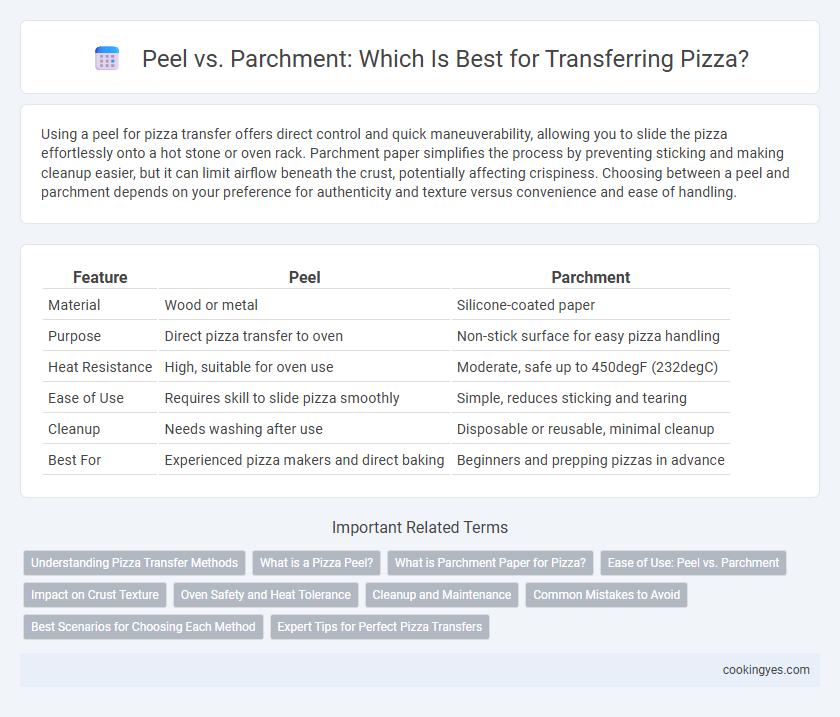Using a peel for pizza transfer offers direct control and quick maneuverability, allowing you to slide the pizza effortlessly onto a hot stone or oven rack. Parchment paper simplifies the process by preventing sticking and making cleanup easier, but it can limit airflow beneath the crust, potentially affecting crispiness. Choosing between a peel and parchment depends on your preference for authenticity and texture versus convenience and ease of handling.
Table of Comparison
| Feature | Peel | Parchment |
|---|---|---|
| Material | Wood or metal | Silicone-coated paper |
| Purpose | Direct pizza transfer to oven | Non-stick surface for easy pizza handling |
| Heat Resistance | High, suitable for oven use | Moderate, safe up to 450degF (232degC) |
| Ease of Use | Requires skill to slide pizza smoothly | Simple, reduces sticking and tearing |
| Cleanup | Needs washing after use | Disposable or reusable, minimal cleanup |
| Best For | Experienced pizza makers and direct baking | Beginners and prepping pizzas in advance |
Understanding Pizza Transfer Methods
Using a pizza peel provides better control and heat resistance when transferring pizza directly into a hot oven or stone, preventing toppings from sliding off. Parchment paper offers a non-stick surface that simplifies transferring delicate pizzas and reduces cleanup but may slightly impact crust crispness. Selecting between peel and parchment depends on the pizza style, dough hydration, and oven temperature for optimal handling and baking results.
What is a Pizza Peel?
A pizza peel is a flat, paddle-like tool made from wood or metal, designed to transfer pizzas to and from a hot oven safely and efficiently. Its broad surface and handle allow for easy sliding of the dough onto baking stones or oven racks without disturbing the toppings. Unlike parchment paper, which is disposable and used as a non-stick barrier, a pizza peel is reusable and essential for handling high-temperature baking.
What is Parchment Paper for Pizza?
Parchment paper for pizza is a non-stick, heat-resistant sheet designed to facilitate easy transfer of pizzas to and from ovens or pizza stones, preventing sticking and reducing mess. Typically made from silicone-coated paper, it withstands high temperatures without burning or releasing harmful chemicals, making it ideal for baking pizza crusts evenly. Using parchment paper enhances clean-up efficiency and protects baking surfaces while maintaining the pizza's texture and flavor.
Ease of Use: Peel vs. Parchment
Using a pizza peel offers superior control and precision during transfer, allowing you to slide the pizza directly onto a hot stone or oven surface with ease. Parchment paper simplifies handling by preventing dough from sticking, making it ideal for beginners, but it may limit crisping and requires careful removal after baking. Overall, a pizza peel is favored by experienced bakers for seamless, efficient pizza transfer, while parchment provides convenience and reduces mess for those new to pizza making.
Impact on Crust Texture
Using a pizza peel for transferring dough allows for a quick, direct slide onto a hot stone or oven surface, helping achieve a crispier, well-aerated crust due to immediate high heat exposure. Parchment paper, while convenient for handling sticky dough, tends to trap moisture underneath the pizza, resulting in a softer, less crunchy crust texture. Professional pizzaiolos often prefer wooden peels to maintain optimal crust texture by minimizing moisture retention during transfer.
Oven Safety and Heat Tolerance
Pizza peels, typically made from wood or metal, offer excellent oven safety and high heat tolerance, allowing direct placement of pizza onto hot stones without risk of melting or releasing toxins. Parchment paper, while convenient for transferring pizza, has a lower heat tolerance, usually up to 450degF (232degC), and can scorch or catch fire in hotter ovens, posing safety hazards. Choosing a wooden or metal peel ensures reliable heat resistance and safe, efficient pizza transfer in high-temperature cooking environments.
Cleanup and Maintenance
Peel and parchment serve different roles in pizza transfer, with cleanup and maintenance varying accordingly. Wooden or metal pizza peels require regular cleaning and occasional seasoning to prevent dough residue buildup and maintain a non-stick surface. Parchment paper offers a disposable, no-mess solution that eliminates the need for scrubbing, making it ideal for quick cleanup but less environmentally friendly than reusable peels.
Common Mistakes to Avoid
Using a peel instead of parchment paper for pizza transfer often leads to sticking or tearing due to insufficient flour or cornmeal on the peel's surface. Common mistakes include improperly flouring the peel, causing the dough to stick and ruining the pizza's shape during transfer. Avoid placing raw pizza directly on a wet or unseasoned peel, which can cause sticking and difficulty sliding onto the stone or oven rack.
Best Scenarios for Choosing Each Method
A pizza peel is ideal for transferring freshly rolled dough onto a hot stone or grill, providing ultimate control and preventing dough sagging during the transfer process. Parchment paper excels when par-baking or using a pizza stone, as it prevents sticking and makes lifting the pizza easier without risking burns or dough distortion. Choosing a peel suits skilled handling with minimal extra tools, while parchment is perfect for convenience and safer transfers, especially for novices or delicate toppings.
Expert Tips for Perfect Pizza Transfers
Using a pizza peel made of wood or metal ensures a sturdy, non-stick surface that facilitates quick pizza transfers without deforming the dough. Parchment paper provides excellent heat resistance and convenience, allowing pizzas to slide easily onto a stone or steel while preventing sticking and mess. Expert pizzaiolos recommend dusting the peel with semolina or flour to reduce friction, ensuring flawless, fast transfers every time.
Peel vs Parchment for pizza transfer Infographic

 cookingyes.com
cookingyes.com